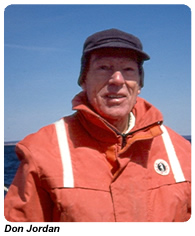Don Jordan
is a retired aeronautical engineer and spent his career in aircraft
and engine development. He has been an enthusiastic sailor all
his life and also was a licensed pilot flying small aircraft on
wheels and floats. 
During the war he worked on the design and development of the
Vought Corsair navy fighter which earned the top combat record
in the Pacific theatre. After the war he became interested in
the new jet engine, and joined Pratt and Whitney Aircraft. He
held a variety of positions there, retiring as Chief Engineer
just as the first engines were being delivered for the Boeing
747 airplane. Subsequent to his retirement he was a Senior Lecturer
at Mass. Inst. of Technology for ten years.
He has served
on many government committees including the Air Force Scientific
Advisory Board and the N.A.S.A Advisory Committee For Airbreathing
Powerplants. In 1976 he was elected to the National Academy of
Engineering.
He now lives
in Glastonbury, CT with his wife Ruby and enjoys his children
and grandchildren.
Don has no
financial interest in the manufacture or sale of the drogue. He
has provided his own funding for the development. He was greatly
assisted by the U.S Coast Guard, who made their facilities available
for testing and analysis and who tested the final configuration
in breaking waves at the Motor Lifeboat School on the Columbia
River bar.
The impetus
for his work was the 1979 Fastnet Race disaster in which 15 lives
were lost and 24 boats were either sunk or abandoned. He felt
that, with his background and with modern engineering tools, such
tragedies need not continue.


